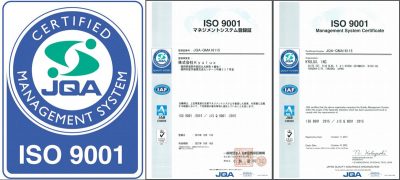Kyulux acquired ISO9001 certification
Fukuoka, Japan, October 21, 2019 – Kyulux Inc., a world leader in the development of the next generation of organic light emitting diode (OLED) Hyperfluorescence™ / TADF technology, has acquired ISO9001 (International Organization for Standardization) certification on October 11, 2019.

Kyulux stated that it will continue to adhere to its mission and vision to create the future of OLEDs using proprietary TADF (Thermally Activated Delayed Fluorescence) and Hyperfluorescence™ technologies.
Quality Policy
Kyulux is committed to the continual improvement of its quality management system, which allows it to fully meet the needs and expectations of the Company’s customers. In keeping with the pursuit of quality, and as a matter of course, Kyulux observes social norms including all laws and regulations.
- Develop the world’s first OLED products incorporating Hyperfluorescence™;
- Ensure that Kyulux’s materials are selected by major display manufacturers for their pilot
testing; - Attract and nurture engineers and technicians willing to aim high and achieve complex
technical goals while meeting deadlines; and - Find reliable partners to whom Kyulux can outsource production, thus establishing a solid
production base.
About Kyulux
Kyulux is a leader in developing and delivering the next generation of organic light emitting diode (OLED) technology, TADF. Founded in 2015, the Company currently owns or has exclusive, co-exclusive or sole license rights to intellectual property from Kyushu University. Kyulux also enjoys an exclusive license to cutting-edge deep learning–based artificial intelligence technology for chemical discovery developed at Harvard University.
For further information please visit: https://kyulux.com
Media Contact: info@kyulux.com
About ISO9001
ISO 9001 is one of the standards within the range of ISO 9000 standards. ISO 9001 is defined as the international standard that specifies requirements for a quality management system (QMS). Organizations use the standard to demonstrate the ability to consistently provide products and services that meet customer and regulatory requirements. It is the most popular standard in the ISO 9000 series and the only standard in the series to which ISO 9001 was first published in 1987 by the International Organization for Standardization (ISO), an international agency composed of the national standards bodies of more than 190 countries.



